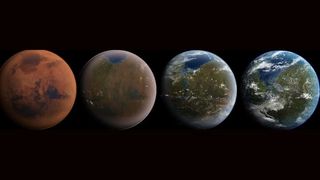
'First tree on Mars:' Scientists measure greenhouse effect needed to terraform Red Planet
"The atmospheric conditions existing on Mars today make the existence of life impossible."

What is the amount of greenhouse warming required to heat up the cold climes of Mars enough so that trees can grow on the Red Planet?
New research points to how much you’ve got to jack up the carbon dioxide (CO2) on Mars to support plant growth, to raise the planet’s temperatures just enough for trees to grow.
Surprisingly, the conditions that would allow plant growth on the Red Planet do not occur first in the "tropics" of the planet.
Energy balance
This futuristic plant growing scenario is led by Robert Olszewski, a professor at Warsaw University of Technology in Poland. He and research associates have led a look at the surface energy balance at Mars, such as the diffusive exchange of heat between carbon dioxide condensation and evaporation, heat exchange with the subsurface, and the transport of heat by atmospheric circulation.
Related: New Mars terraforming idea: engineered, heat-absorbing dust nanoparticles

"Surprisingly, the conditions that allow plant growth do not occur first within the tropics (±25°) but in the Hellas Basin region. A further increase in the greenhouse effect expands the area suitable for plant growth in the southern hemisphere," a new research paper explains.
Using in part Viking Mars lander temperature and pressure datasets gleaned in the 1970s, Olszewski and research team members have simulated a variety of processes on Mars, both at present and in past/future epochs.
Get the Space.com Newsletter
Breaking space news, the latest updates on rocket launches, skywatching events and more!

"Here, we use the baseline model to investigate the greenhouse effect caused by an increase in CO2 plus artificial greenhouse warming," Olszewski notes in a paper presented at an "Astrobiology and the Future of Life Meeting" held recently at the Lunar and Planetary Institute in Houston, Texas.
Pressure cooker
Olszewski and colleagues assessed the total pressure on Mars needed, the high percentage of acceptable CO2, the O2 needed, amount of water available, and the range of temperatures necessary for tree growth.

The atmospheric conditions existing on Mars today make the existence of life impossible,” Olszewski points out. “The requirements for plant growth on Mars have been considered in the context of terraforming and for low-pressure greenhouses.”
The research focused on temperature "as this is the fundamental environmental variable that changes during terraforming and it controls the CO2 cycle and the formation of liquid water," Olszewski adds. Oxygen levels in a thick warmer atmosphere remain an important separate concern.
Growing season
"Focusing on the temperature, it must be several tens of degrees higher, while the diurnal fluctuations should be much lower. For the growth of trees, the growing season must last at least 110 sols (Martian days)," the research shows, given a certain minimum temperature, average temperature, and maximum temperature that could be reached on the Red Planet.
Olszewski and research colleagues point out that, on Earth , the highest elevation treelines are primarily found in the tropics – but modulated by the location of the thermal equator. "Thus, it may be expected that equatorial regions of Mars would be the location of the first tree."

But due to Mars’ relatively large orbital eccentricity, the southern hemisphere, which has summer near perihelion, has relatively warm summers, the researchers observe. In addition, the orbital period of Mars is 1.9 Earth years.
Therefore, the long warm southern summer provides the first growing season suitable for trees," Olszewski reports. "Specifically, we find that the low elevation of the Hellas Basin allows the creation of the first conditions favorable to tree growth," the researchers conclude.
Join our Space Forums to keep talking space on the latest missions, night sky and more! And if you have a news tip, correction or comment, let us know at: community@space.com.

Leonard David is an award-winning space journalist who has been reporting on space activities for more than 50 years. Currently writing as Space.com's Space Insider Columnist among his other projects, Leonard has authored numerous books on space exploration, Mars missions and more, with his latest being "Moon Rush: The New Space Race" published in 2019 by National Geographic. He also wrote "Mars: Our Future on the Red Planet" released in 2016 by National Geographic. Leonard has served as a correspondent for SpaceNews, Scientific American and Aerospace America for the AIAA. He has received many awards, including the first Ordway Award for Sustained Excellence in Spaceflight History in 2015 at the AAS Wernher von Braun Memorial Symposium. You can find out Leonard's latest project at his website and on Twitter.
-
Unclear Engineer Maybe the authors of this article should read this previous article: https://www.space.com/31044-mars-terraforming-nasa-maven-mission.html , which says the CO2 just isn't there in sufficient quantities to terraform Mars, because it was swept away by the solar wind billions of years ago. So, even if we somehow find more CO2 than currently expected and try to get it into the Martian atmosphere, would we be able to get it in faster than the Sun takes it out? And, if we could achieve that, how long would it last?Reply